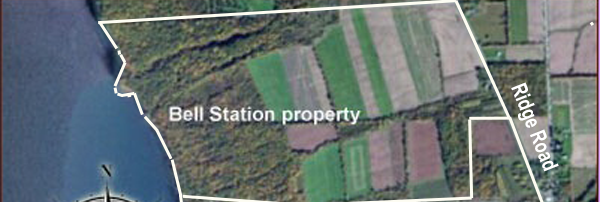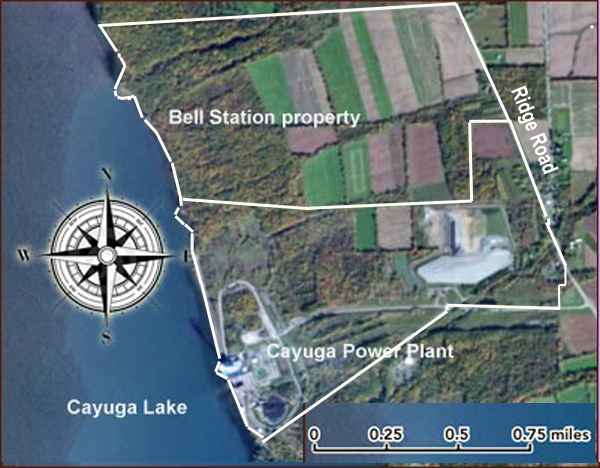- By Dan Veaner
- News
 Print
Print 
Last week Finger Lakes Land Trust Executive Director Andrew Zepp met with the Town of Lansing Conservation Advisory Council to discuss how a proposal for a 100 to 200 megawatt solar facility would impact a possible state park on what is now the NYSEG-owned Bell Station property -- about 490 acres with the largest undeveloped shoreline on Cayuga Lake, amounting to 3,500 feet -- in the north-west of the Town. Zepp said that if the Cayuga Solar project (with sPower developing the project) takes a couple of hundred acres of Bell Station land for a solar array, there wouldn't be enough land for a state forest -- the only way the Town could receive tax payments from New York State. But he said he wants to explore whether the Town would still want tax payments from the State if it can negotiate a lucrative benefit package with the solar developers.
"About half of the Bell Station property is wooded, shoreline and bluff; and about half is leased corn and soybeans, maybe some hay," Zepp said. "I have had conversations with several folks in Lansing. One is what does the community feel about this? But two... typically larger solar farms have a significant host benefit compensation package. And there's a fundamental question is if the Town supported a solar farm that included the field phones, would it feel differently about the necessity of having Payment In Lieu Of Taxes (PILOT) on the shoreline, which would now be difficult if not impossible, if you don't have the couple of hundred acres that the solar folks want."
Zepp said he has also been feeling out the New York State Department of Environmental Conservation (DEC) to see if the State would still be willing to own and manage 250 acres of natural land, if the Town is willing to take that piece off the tax roles, instead receiving income from the solar project. He added that there are some small wooded areas contiguous to Bell Station land and owned by the Cayuga Operating Company (COC, which operated the now-closed power plant and intends to replace it with a cloud data center) that he is hoping COC would be willing to add to the preserved land.
The Town is discussing a number of possible local payment plans with the developer, and the final number may be determined by the State. Zepp noted that the Public Service Commission (PSC) is currently reviewing new rules for industrial solar and wind projects and the current thinking is that local municipalities might be paid $500 per megawatt. That particular project is estimated at 100 to 200 megawatts depending on how much land they can acquire in addition to COC property, making the potential annual payment to the Town between $50,000 and $100,000.

Zepp originally approached the Town Board in 2012 with a proposal to transform the 490 acre Bell Station property into a state forest or park. At that time he proposed the Land Trust could purchase the property and hold onto it until such a time as money became available for the State to purchase and maintain it. In 2013 the Town Board was split on whether it wanted the land to be preserved or kept on the tax roles for private development, but when 25 people spoke in favor of preserving the land the Board passed a resolution supporting a potential state-owned public area provided that the State would pay ongoing property taxes comparable to current levels.
State wildlife areas don't usually pay local property taxes, but state forests do. The State requires at least 500 acres for state forests, but a park or protected area could be smaller. If the land were to be declared a state forest, an additional, contiguous 10 acres would have to be purchased. Zepp said that only state forests can have a PILOT agreement, and the only way a wildlife management area can generate payments to a municipality is by special legislation. He said that getting Albany to pass such legislation is very difficult because if one area manages to get it, all areas across the State will want it, creating a legislative quagmire.
"It's not impossible, but your Senate district includes the Northern Montezuma wetlands complex, which has a lot of wildlife land off the tax rolls. So it would be very difficult politically to pass legislation for Lansing and not the poor Town of Savannah where there's extensive acreage. And the minute you do that, there are a lot of other communities in the state that are also seeking the same thing. So it's not impossible, but it's very difficult. Back when Senator Nozzolio was in office, he said there is no way he could do Lansing and not the rest. And he thought the feasibility was dubious," Zepp explained.
All of this is still theoretical in part because NYSEG had not indicated that the property was for sale even though the State has declared it is interested. Rules for industrial solar are also up in the air at this time, as the PSC is holding public hearings in support of locking down exactly how the State will exercise its control over large projects, and how much influence local municipalities will have on things like buffers between large solar fields and existing private property, or the ability to negotiate benefits such as taxes from PILOT agreements or potentially reduced electricity rates for local residents and businesses.
The Conservation Advisory Council is one of a number of advisory committees that recommends actions to the Town Board, which has the authority to make law and determine what is acceptable to the Town. The Board voted last week to send letters of support for two major projects including the sPower/COC proposal and the 'Yellow Barn Solar' project being developed in Lansing and Groton near the portion of Buck Road east of Auburn Road (State Route 34). Both must submit applications to the New York State Energy Research and Development Authority (NYSERDA) by October 21st.
Town Councilwoman Andra Bensonand Councilman Joe Wetmore said they would be interested in considering the possible scenarios if the committee forwards them to the Town Board. Benson said the meeting was the first time she had heard of some of the possible scenarios, and she thought the full Board would be interested in revisiting its position. Wetmore agreed.
"I think that exploring keeping this a natural area is really an important thing for the town as a whole. There's not much lakefront property property that will ever become available again. And if we lose this, we lose it forever. And this is our one chance to preserve it for future generations. That's a real priority for me," Wetmore said.
Making this dream a reality is a web of 'ifs' -- if, if, if. If NYSERDA accepts the sPower application. If sPower can obtain enough land including the corn, soybean, and hay fields on the eastern portion of the property. If PSC sets rules including allowing adequate payments to municipalities. If the If the Board can be convinced that the loss of income from a PILOT for the whole Bell Station property can be reasonably offset by payments generated by the sPower project, Lansing may yet have a state wildlife management area along the shore of Cayuga Lake that is open to the public-- again dependent on the biggest unknown: if NYSEG decides to sell the property.
v16i41



